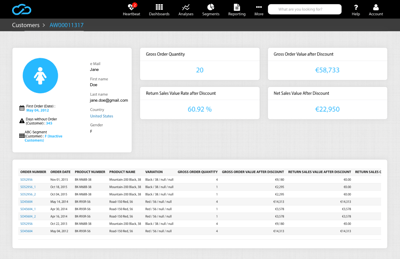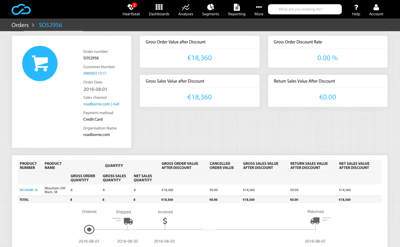Omni-Channel is not a buzzword. Not only has this year's dmexco shown that the great vision of a comprehensive channel experience is more and more a reality, but also, in our work with specific brands and retailers, this is becoming increasingly noticeable. And, in fact, omni-channel does not have to be as far away as it may seem to be for people. To illustrate this, we will show you in this article how companies can become, right now, real omni-channel organizations with tools like our freshly launched Single View Pages.
8:45 – Omni-Channel Director: Sales low in the Mobile App!
On the way to an appointment, FashionRetailer's Omni-Channel Director checks his business insights stream on his smart phone -- and he discovers a sales channel alert: the revenue generated through the mobile app has fallen sharply. One click on the Single Sales Channel Page behind it and the reasons become clear: The low number of orders traces back to a small number of visitors, which, in turn, is due to a miserable email campaign. The Omni-Channel Director sends the alert to his Head of Marketing: The order numbers have to be improved in the short term, action has to be taken!
9:00 AM – Head of Marketing: Ad-Hoc Campaign to Increase App Sales
In the office, the redirected alert reaches the Head of Marketing. Falling app sales because of a mishandled email campaign? In fact, clicking on the Single Campaign Page reveals a significantly underperforming conversion rate. So what needs to be done? Low conversion rates cannot always be avoided (although they certainly have to get to the bottom of the matter). In the mind of the Head of Marketing, a campaign is being created -- the goal: more app downloads! In addition to a short-term increase in the number of orders, an increase in the number of app users also results in a more sustainable effect so that conversion slip-outs will be better absorbed in the future. The Head of Marketing decides to consult with the Head of Merchandising about the campaign content.
9:10 – Head of Merchandising: Get rid of the Sneakers!
 When the Head of Marketing arrives at the desk of the Head of Merchandising, the latter of whom is taking a look at the dashboard with the performance figures from the day before, which is sent to him by email every morning. When the Head of Marketing describes his idea, the Head of Merchandising points to the product category of sneakers, where he has observed a significant performance drop for several days. Via the relevant Single Category Page, it shows that a certain model of the brand CoolShoes is to blame! For this former top seller, sales have fallen sharply earlier than expected, but the stock is still full.
When the Head of Marketing arrives at the desk of the Head of Merchandising, the latter of whom is taking a look at the dashboard with the performance figures from the day before, which is sent to him by email every morning. When the Head of Marketing describes his idea, the Head of Merchandising points to the product category of sneakers, where he has observed a significant performance drop for several days. Via the relevant Single Category Page, it shows that a certain model of the brand CoolShoes is to blame! For this former top seller, sales have fallen sharply earlier than expected, but the stock is still full.
A simple ad-hoc analysis leads to the following plan: A high number of customers bought the predecessor model of the underperforming sneakers in the previous season, but they are not buying the successor. Since the vast majority of these customers made their purchases in the web shop and store, this is a good opportunity to move them into the app channel -- with the offer to get a 30% reduction on the newer CoolShoes model when buying through the newly downloaded app. This not only attracts new app users and boosts the order numbers, but also, the warehouse gets rid of the annoying old stocks. With just a few clicks, the corresponding customer segment is compiled, and the Head of Marketing briefs his team on how to implement the short-term campaign with the help of email and Facebook Target Audience.
9:40 – Merchandising Manager: Top Seller Stock is Running out
At the desk next to the Head of Merchandising, a Merchandising Manager sits and checks her daily business insights stream for abnormalities outside the normal ranges. And indeed, there is a low on stock alert: two top sellers are expected to be out of stock tomorrow. One glance at the Single Product Page shows remaining stocks and performance of the single product variations, so the goods can be reordered quickly and the alert is marked as completed -- before the boss notices it.
13:20 – Seller in the Store: What do I Recommend to my Customer?
 A couple of hours later, a customer enters a FashionRetailer store to return a dress purchased online. By processing the return, the seller can identify the customer -- as the customer looks around in the shop, the seller opens the corresponding Single Customer Page and scrolls through the customer's shopping history. He wants to find out which product he can recommend. Aha: The customer regularly buys Medium-sized jeans from the brand FancyPants. Since two new models have arrived in the previous week, the salesman grabs these pants and succeeds in convincing the customer to purchase one of them.
A couple of hours later, a customer enters a FashionRetailer store to return a dress purchased online. By processing the return, the seller can identify the customer -- as the customer looks around in the shop, the seller opens the corresponding Single Customer Page and scrolls through the customer's shopping history. He wants to find out which product he can recommend. Aha: The customer regularly buys Medium-sized jeans from the brand FancyPants. Since two new models have arrived in the previous week, the salesman grabs these pants and succeeds in convincing the customer to purchase one of them.
 But the customer still has a wish: During payment, she inquires about an online order, which she placed the previous week, but which has not yet arrived. The seller can help: From the customer's single customer page, he can click directly on the Single Order Page of the said order -- and find that the order has not yet left the warehouse. He promises to pursue the matter. The customer goes home content.
But the customer still has a wish: During payment, she inquires about an online order, which she placed the previous week, but which has not yet arrived. The seller can help: From the customer's single customer page, he can click directly on the Single Order Page of the said order -- and find that the order has not yet left the warehouse. He promises to pursue the matter. The customer goes home content.
16:00 – Weekly Management Meeting: In Which Markets do we Invest?
 A little bit later, in the office, the weekly management meeting begins. For quite some time, the CEO has been looking more closely at online sales in France, that, since the opening of two stores in Paris, have been growing steadily over the last few weeks – as shown by the daily, weekly and monthly overview reports, which the CEO gets sent automatically to his email inbox. Brand building and channel migration campaigns (store → web shop) worked excellently! Now he would like to discuss, during the weekly meeting, how to invest more resources also into French online sales. With the performance details on the Single Country Page, he shows his team that France has actually risen to be in the Top 5 of the most powerful sales markets of FashionRetailer and they have been there for a month – so the decision is made quickly: more budget for the French online business!
A little bit later, in the office, the weekly management meeting begins. For quite some time, the CEO has been looking more closely at online sales in France, that, since the opening of two stores in Paris, have been growing steadily over the last few weeks – as shown by the daily, weekly and monthly overview reports, which the CEO gets sent automatically to his email inbox. Brand building and channel migration campaigns (store → web shop) worked excellently! Now he would like to discuss, during the weekly meeting, how to invest more resources also into French online sales. With the performance details on the Single Country Page, he shows his team that France has actually risen to be in the Top 5 of the most powerful sales markets of FashionRetailer and they have been there for a month – so the decision is made quickly: more budget for the French online business!
Conclusion: Omni-Channel is not Witchcraft
It does not always have to be the perfect and fully automated marketing machine: Omni-Channel has already started once the strict channel concept ceases and a company understands itself as one team which meets the customer's wishes – regardless of channels or devices. The prerequisite for this is, at first, merely that all employees look at the same data and understand what is happening in their company and why – so that they can always make the best decisions for the business.
Analytics features such as the minubo Heartbeat (proactive insights stream), or the minubo Single View Pages, can be particularly helpful: With them, every employee is able to make data-driven decisions quickly and easily without complex analysis work.
If this sounds interesting to you, please contact us at contact@minubo.com or +49 (0) 40-398 06 75-101 and ask us to tell you more! You can also find more information about the newly launched Single View Pages here:


 nach Wunsch auch mit Videocall
nach Wunsch auch mit Videocall